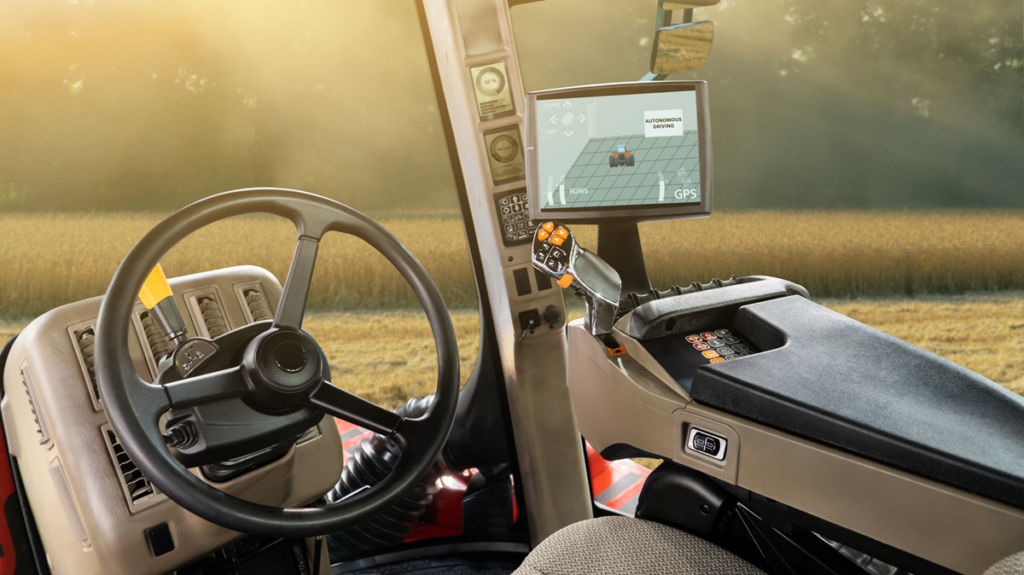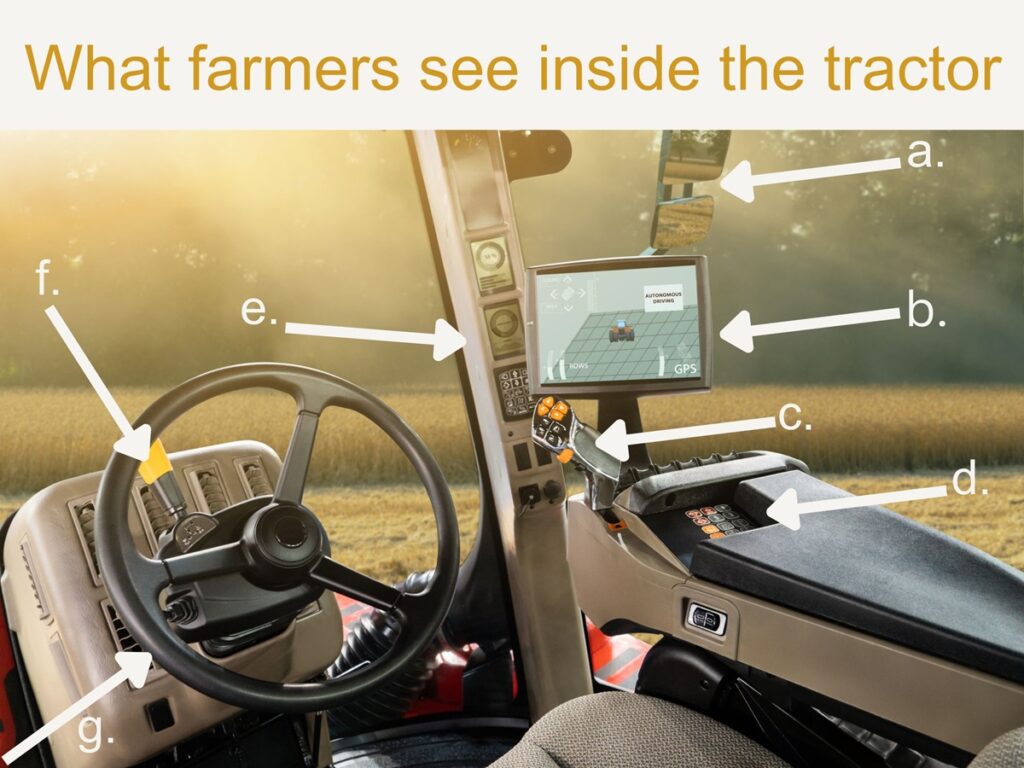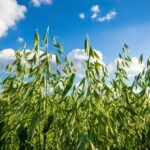What farmers see inside the tractor

We’ve highlighted the different equipment farmers use on their farms. The most important equipment they use is a tractor. Until the early 1920s, farmers used horses to do many tasks a tractor can do today. Today, they are used for a wide variety of jobs on the farm. Whether it’s pulling implements for tillage, planting, or hauling grain, tractors are capable of pulling these heavy loads!
While tractors have a lot of power and capabilities, the person in the seat has all of the control of the tractor. Have you ever wondered what farmers see inside the tractor? Or how the tractor drives and performs all of its tasks? Take a look at the diagram below and learn about what each component does!

a. Mirrors
Just like when we drive cars, it is important for farmers to see all around them when driving their tractors. Tractors often pull wide and/or long pieces of equipment behind them, so having mirrors showing a variety of angles is key. Farmers can angle their mirrors so that they can see the most out of them from where they are seated.
The bottom mirror is angled towards the ground so the farmer can clearly see both the ground and the side of the tractor. This mirror will help ensure they keep the tractor straight in line. Keeping the tractor straight aids in efficiency and prevents the farmer from having to drive down the rows more than necessary. The upper mirror is angled further out so that the farmer can see not only their tractor length but the whole length of the piece of equipment they may be pulling. This is especially important when driving on the road. Farmers need to be able to see past their load to see cars or ensure they turn wide enough that the whole unit makes it around a corner safely.
b. GPS monitor
You may notice that the inside of a tractor has a lot of technology. Farmers have screens, sensors, and monitors inside their tractor cab that help them operate and monitor a lot of jobs a tractor does on a farm. Tractors have come a long way technologically and are always advancing to be more efficient and helpful to grain farmers. Many newer tractors are equipped with some form of a Global Positioning System (GPS). In the picture, you can see a picture of the monitor that farmers use to watch their GPS. Farmers can use GPS to track a field and its dimensions for future use. This prevents having to calibrate the system every time a farmer enters the same field. GPS is also used to provide guidance, much like a GPS in a car. While in a car, a GPS helps keep the driver from getting lost; in a tractor, it offers guidance on driving efficiently throughout a field.
c. Throttle controls
The throttle controls are located within arm’s reach of the farmer, as it needs to be accessible at all times. This control is important for various tasks that the tractor may perform. Instead of gas pedals like cars, farmers use a tractor’s forward motion to push the throttle ahead, increasing the speed. There are also some buttons that a farmer can quickly press if needed while controlling the speed to control other aspects of the tractor. Much like in a car, where drivers have access to windshield wipers, turn signals, Bluetooth, etc., within easy reach on the steering wheel, in a tractor, there are buttons on the throttle control.
d. Armrest controls
The armrest controls are a series of buttons that perform different tasks within the tractor. An example is autosteer, which will keep the tractor in a straight line without using the steering wheel. Another control is the button that will put the tractor into four-wheel drive. Sometimes, tractors can drive into fields that are muddy or slippery, and having access to four-wheel drive is needed!
e. Gauges
Located to the right of the steering wheel inside of a tractor, you will see a variety of different gauges. These tell the farmers a few different things while they are driving. These are the same ideas as having a gas gauge or oil temperature gauge on the dash of a car. One gauge is a speedometer; this is how the farmer can see how fast they are driving. Another example would be the tachometer, a fancy name for the gauge that monitors the RPM or revolutions of the engine per minute. The RPM represents how fast the tractor’s engine is spinning – the engine makes more power the faster it spins. This is important to monitor because tractors are machines that pull and operate equipment like a planter or grain buggy. Farmers need to know how much power the tractor uses to operate that equipment so they monitor the RPM while working.
f. Shuttle lever
The black and yellow leaver near the top of the steering wheel performs a simple but important task. The purpose of a shuttle lever is to put the tractor in different driving modes: forward, reverse, neutral, and park. It is much like a car’s gear shift!
g. Steering wheel
Tractors have more similarities with cars; another similarity is the steering wheel. It has one simple job: to steer! The steering wheel can be positioned at various heights so it is at a comfortable position regardless of who is driving. Farmers use the steering wheel while driving on the road, in the field, or when parking. It is used to make large turns or to turn around and help keep the tractor straight while driving in the field.
Tractors are arguably the most important tool on a farm and can be used year-round to plant grains, work the soils in the fields, spray the crops, haul harvested grain, and even used in the winter to move snow. They are the “workhorses” on many farms and are high-tech to help farmers operate their farms sustainably and efficiently.



